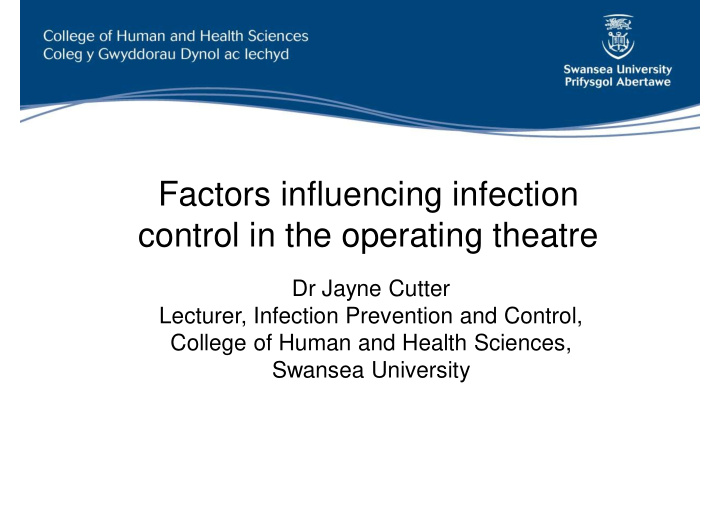



Factors influencing infection control in the operating theatre Dr Jayne Cutter Lecturer, Infection Prevention and Control, College of Human and Health Sciences, Swansea University
� Factors influencing sustaining inoculation injuries by healthcare professionals undertaking exposure prone procedures in the operating theatre � � A cross sectional survey of all surgeons and scrub nurses in 6 acute trusts in Wales was undertaken, response rate 51.47% (n=315). � A purposive sample of 16 respondents participated in a series of semi- structured interviews. � The senior Infection Prevention and Control Nurse of each trust was interviewed by telephone (n=6). � Statistical analysis (inferential statistics) was employed to explore the relationships between key variables. � Logistic regression modelling was used to predict the likelihood of sharps injuries. � Content analysis was employed to analyse interview data
Sharps � injuries within the last 5 years by profession Sharps injury within 5 Total years None 1 or more Surgeons Count 61 119 180 (100%) (% within profession) (33.9%) (66.1%) Scrub nurses Count 71 64 135 (100%) (% within profession) (52.6%) (47.4%) Total Count 132 183 315 (100%) (%) (41.9%) (58.1%)
Use of precautions 100% 90% 80% 70% Other Percentage 60% Never 50% Known or suspected infection 40% All patients 30% 20% 10% 0% Safety Avoid Eye Double device passing protection glove sharps Precaution
� Education, education, education... � � A beneficial effect of under-graduate education is suggested by the fact that nursing and medical students, junior doctors and nurses are more likely to comply with precautions than those who are older and have been in practice longer � Students are a � captive � audience resulting in high attendance � Securing attendance at mandatory infection prevention and control training may be more problematic
The perceived value of mandatory education � � Well I know that pointed things are sharp and they hurt and they shouldn � t stick into me but I don � t know .... unless they are going to teach me different ways of practicing in which case they should come into the theatre and tell me that anyway without me having to go off on a separate half day bonding session � (Surgeon) � � And it will be of no use � (Surgeon)
Education � All successful models for altering behaviour rely on the subject believing change is necessary � The carrot approach relies on adapting education to the needs of the audience and requires recognition of what influences practice
What influences practice? Profession Interference with working practices Availability of resources Time pressures Expectations Perceptions of teamwork Hierarchy Risk perception and risk taking behaviour Occupational hazard Peer pressure
Improving compliance through education � Flexibility � incorporate adult learning theories � Know your audience � Personal sessions for each profession � Utilize � opinion leaders � � Consider the use of various behaviour change theories that have been successful in modifying health behaviour e.g. the transtheoretical model (Prochaska and DiClemente (1979)
In summary: � Behaviour change represents a reciprocal web of biological, socio-cultural, and psychological factors � People change over time and they can learn and grow from unsuccessful attempts at change � People modify behaviour most effectively when they see � change � in the context of factors that matter the most to them
Recommend
More recommend